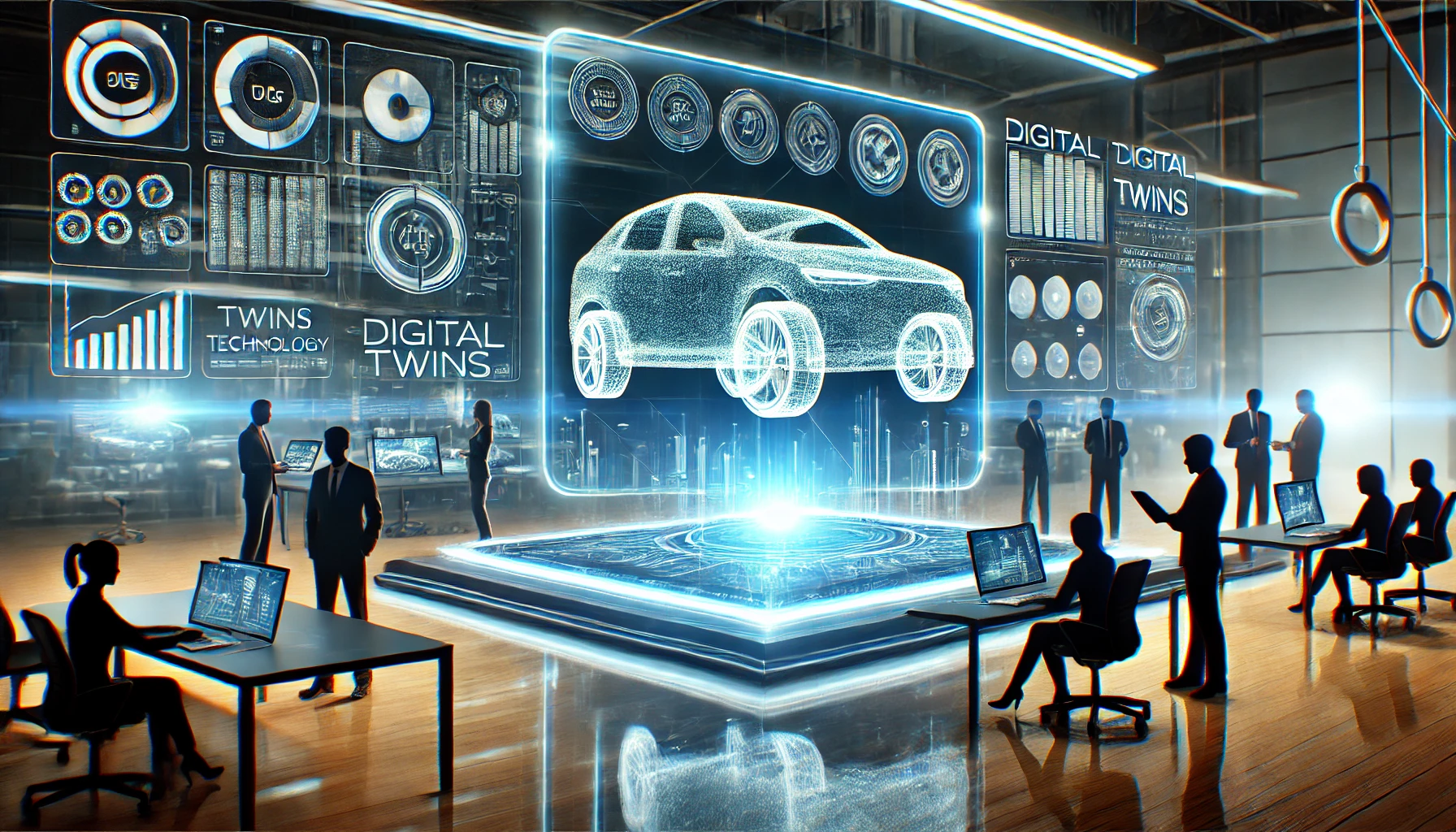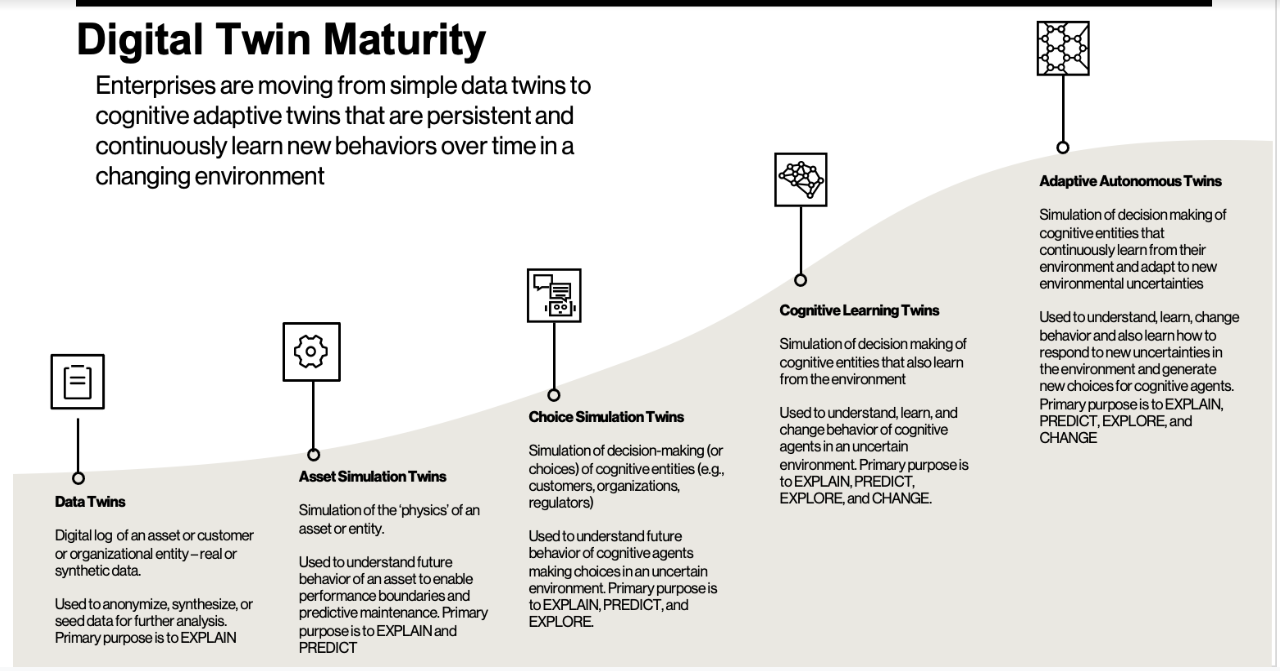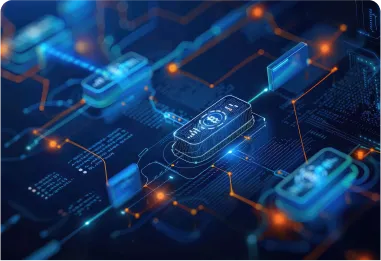The advent of Digital Twins marks a significant milestone in our journey towards an interconnected digital realm. These dynamic virtual replicas of physical assets are not merely simulations; they are the bridges that link the real world with digital insights, enabling businesses to optimize operations, reduce costs, and innovate at scale. As we delve into the world of Digital Twins, it’s essential to understand how they function, their applications across various industries, and how companies like Sphere are at the forefront, guiding businesses toward harnessing this transformative technology to achieve advanced levels of operational efficiency and strategic insight.
What are Digital Twins?
The Concept of Digital Twins
A Digital Twin is a dynamic virtual model of a physical object, process, system, or service. This technology enables the simulation, visualization, and analysis of data to mirror real-life processes or systems in real time. Digital Twins serve as a bridge between the physical and digital worlds by using sensors to gather data from real-world objects and environments to update their digital counterparts continuously. This allows for detailed reflections of the real world in a virtual space, providing invaluable insights and foresight into the performance, maintenance, and optimization of physical assets.
Historical Context
The concept of Digital Twins was first introduced by NASA during the early space missions, where it was crucial to have an exact replica of the space capsules on earth to simulate conditions in space. This early application was primarily for problem-solving in simulations, which helped in executing missions successfully. Over the years, the rise of IoT and advancements in big data and analytics have greatly expanded the applicability and functionality of Digital Twins, transforming them into a tool not just for simulation but also for real-time monitoring and predictive maintenance.
Market Growth and Size
The Digital Twin market has seen substantial growth over recent years. According to a report from Global Market Insights, the Digital Twin market size, estimated at $3 billion in 2018, is projected to grow to $20 billion by 2025. This rapid growth is indicative of the increasing adoption and integration of IoT across various sectors, enhancing the capabilities and applications of Digital Twins.
Key Statistics and Trends
The adoption of Digital Twins is becoming more widespread across industries. A statistic from Gartner highlights that 75% of organizations using IoT have already implemented Digital Twins in 2019. This significant adoption rate reflects the critical role Digital Twins play in modern business strategies, especially in enhancing operational efficiency, reducing costs, and driving innovation.
Digital Twins leverages real-time data to create dynamic virtual models of physical systems. The technology has evolved from its early aerospace applications to become a staple in industries ranging from manufacturing to healthcare, driven by significant investments and the integration of advanced analytics and IoT. The market for Digital Twins is rapidly expanding, underscoring their growing importance and the benefits they deliver across various sectors.
Unleash the Potential of Digital Twins
Talk to our experts to explore how Sphere’s Digital Twins technology can transform your business operations. Dive into a new era of innovation!
Types of Digital Twins
Digital Twins vary widely in complexity and scope, ranging from simple replicas of individual components to sophisticated models of entire systems or processes. Understanding the different types of Digital Twins is crucial for organizations looking to implement this technology, as it helps tailor the digital twin to specific operational needs and strategic objectives. Let’s outline the primary types of Digital Twins and their specific applications across various industries.
Component Digital Twins
Component Digital Twins represent individual components or parts within a larger system. They are the most basic type of Digital Twin and are primarily used to monitor the health and performance of specific parts.
Applications:
- Manufacturing: Monitoring the wear and tear of machine parts to predict failures and schedule maintenance.
- Automotive: Tracking the condition of critical vehicle components like engines or braking systems to enhance safety and reliability.
Product Digital Twins
Product Digital Twins encompass entire products or machines, providing a holistic view of an item’s performance throughout its lifecycle. These twins are more complex, integrating multiple component twins.
Applications:
- Consumer Electronics: Analyzing usage patterns and performance to improve product design and user experience.
- Aerospace: Simulating aircraft performance under various conditions to enhance design and operational efficiency.
Process Digital Twins
Process Digital Twins model the operations and processes of a manufacturing or production system. They are used to optimize workflows and increase efficiency at the process level.
Applications:
- Manufacturing: Streamlining production lines by simulating different operational strategies and detecting inefficiencies.
- Energy: Optimizing power generation processes to maximize output and reduce fuel consumption.
System Digital Twins
System Digital Twins are the most complex, modeling entire systems or networks. These twins integrate multiple product and process twins, providing insights into the interactions and dependencies within the system.
Applications:
- Smart Cities: Managing urban infrastructure systems such as transportation, utilities, and public services to improve efficiency and sustainability.
- Healthcare Systems: Simulating hospital operations to optimize workflows, resource allocation, and patient care.
Performance Digital Twins
Performance Digital Twins are designed to predict the performance and outcomes of systems under various scenarios. They are often used for scenario planning and decision support.
Applications:
- Sports Engineering: Analyzing athlete performance under different training regimes to tailor coaching strategies.
- Project Management: Simulating different project paths to predict outcomes and identify risk mitigation strategies.
The choice of which type of Digital Twin to deploy depends on the specific needs of the organization and the complexity of the systems involved. By selecting the appropriate type of Digital Twin, organizations can gain a significant advantage in monitoring, maintaining, and optimizing their operations. Whether it’s enhancing a product, refining a process, managing a system, or predicting performance, Digital Twins provide a strategic tool to drive innovation and efficiency across industries.
Digital Twin Technology
Overview of Enabling Technologies
Digital Twin technology represents a convergence of several cutting-edge technologies, each playing a pivotal role in the creation, maintenance, and utilization of these virtual models. The primary technologies that make up the backbone of Digital Twin applications include the Internet of Things, Artificial Intelligence, Machine Learning, cloud computing, and Extended Reality. These technologies work in synergy to collect, analyze, and visualize data in a way that digital replicas can mimic their physical counterparts with high fidelity.
Internet of Things
The Internet of Things is fundamental to the functionality of Digital Twins. IoT devices equipped with sensors are attached to physical assets to collect data on their condition, operation, and environment. This data is crucial as it feeds the Digital Twin with real-time information, allowing the twin to reflect the current state of the physical asset accurately. Every change in the physical asset is recorded and mirrored in the digital model, ensuring the twin is always an exact replica of its real-world counterpart.
Artificial Intelligence and Machine Learning
AI and ML are the brains behind the operation, analyzing vast amounts of data collected by IoT sensors to detect patterns, predict outcomes, and suggest optimizations. These technologies enable Digital Twins to simulate different scenarios and forecast potential problems before they occur in the real world, providing businesses with valuable insights to make informed decisions. For instance, AI algorithms can predict when a machine is likely to fail, allowing for preventative maintenance that minimizes downtime and extends the asset’s lifespan.
Cloud Computing
Cloud computing provides the infrastructure needed to store and process the enormous amounts of data generated by Digital Twins. It supports the scalability of Digital Twin applications by allowing businesses to expand their digital replication efforts without the need for significant physical infrastructure. The cloud enables seamless access to the Digital Twin from anywhere, facilitating remote monitoring and management of assets distributed across various locations.
Extended Reality or XR
XR technologies, including Virtual Reality, Augmented Reality, and Mixed Reality, enhance the visualization aspects of Digital Twins. These tools allow engineers, designers, and operators to interact with the digital replicas in a more intuitive and immersive way. For example, AR can overlay a Digital Twin on a physical machine, helping technicians to perform maintenance by showing them what components lie inside and highlighting any potential issues.
Innovative Applications and Future Potential
Digital Twin technology is continuously evolving, pushing the boundaries of what can be simulated and analyzed in a virtual environment. One exciting development is the integration of Digital Twins with advanced simulation technologies that can model complex systems like city infrastructures, weather systems, or even human organs. This integration opens up new possibilities for predictive analytics, urban planning, healthcare, and many other fields.
Digital Twin technology is powered by a suite of advanced technologies that collectively enable the creation of accurate, real-time digital replicas of physical assets. Sphere leverages its expertise in IoT, AI, ML, cloud computing, and XR to develop tailored Digital Twins solutions that meet specific business needs, ensuring that clients can both mirror and enhance their real-world operations through advanced digital simulations. As these technologies continue to advance, the scope and impact of Digital Twins are set to expand, revolutionizing how industries operate and innovate.
Optimize with Precision
Leverage Digital Twins for real-time monitoring and predictive maintenance with Sphere. Stay ahead, stay efficient!
Examples of Digital Twins
Digital Twins are increasingly becoming an integral part of various industries, offering significant advantages by enabling businesses to simulate, predict, and enhance their operations. In this section we explore several compelling examples of Digital Twins across different sectors, showcasing their diverse applications and the benefits they bring to organizations.

Manufacturing: Siemens
Siemens extensively uses Digital Twins for product design, production process simulations, and the performance monitoring of their products and systems. By creating a digital replica of their entire production line, Siemens can simulate and optimize the manufacturing process before the physical setup. This preemptive analysis helps in reducing waste, shortening development cycles, and improving overall operational efficiency. For instance, in their gas turbine manufacturing, Digital Twins are used to predict and optimize the lifespan and efficiency of turbines under different operational conditions.
Aerospace: Boeing
Boeing is another prime example of Digital Twins in action. They use Digital Twins to simulate aircraft systems and components for better maintenance and operation. Boeing’s Digital Twins collect real-time data from sensors embedded in their aircraft, allowing them to monitor the aircraft’s health and predict when maintenance is needed. This proactive approach significantly reduces unplanned downtime and extends the aircraft’s operational life, thereby enhancing safety and efficiency.
Healthcare: Personalized Medicine
In the healthcare industry, Digital Twins are revolutionizing personalized medicine. Hospitals and research facilities are developing Digital Twins of human organs to study diseases and simulate the effects of potential treatments without any risk to actual patients. For example, Digital Twins of hearts or lungs can help doctors understand the progression of diseases like heart disease or asthma and test different treatment options to find the most effective solution for an individual patient.
Automotive: Tesla
Tesla leverages Digital Twin technology to enhance vehicle diagnostics and maintenance. Each Tesla vehicle has a corresponding Digital Twin that receives data continuously from the car’s sensors. This setup allows Tesla to monitor each vehicle’s performance in real-time and predict potential issues before they become significant problems, ensuring high reliability and customer satisfaction. Tesla can also use the accumulated data to improve future car designs and enhance existing features via remote software updates.
Energy: GE Renewable Energy
General Electric (GE) utilizes Digital Twins to optimize the performance of their wind turbines. By analyzing data collected from sensors installed on the turbines, GE’s Digital Twins can predict weather conditions and adjust turbine operations to maximize energy output and minimize wear and tear. This technology not only increases the efficiency of wind farms but also extends the lifespan of the turbines, reducing maintenance costs and downtime.
Smart Cities: Singapore
Singapore, known for its commitment to technology and sustainable development, employs Digital Twins to optimize urban planning and public services. The virtual model of the city allows planners to simulate traffic flows, disaster management scenarios, and energy consumption across different areas. This helps in making data-driven decisions that improve residents’ quality of life, enhance public safety, and reduce environmental impact.
Athletic Training: U.S. Swim Team
Digital Twins enhance the U.S. swim team’s training for the 2024 Paris Olympics by creating virtual replicas of swimmers to analyze and optimize their techniques. This approach provides detailed insights into performance, allowing coaches to tailor training programs to improve swimmer efficiency and effectiveness. This innovative approach helped the athletes achieve higher performance levels and reduced the risk of injuries, showcasing the significant potential of digital twins in sports training and performance enhancement.
These examples demonstrate the versatility and transformative potential of Digital Twins across various sectors. From manufacturing to healthcare, aerospace, automotive, energy, and urban planning, Digital Twins enable more informed decision-making, optimize operations, and drive innovation. Sphere collaborates with leading industries like manufacturing and healthcare to deploy customized Digital Twins, enhancing operational efficiency and predictive maintenance strategies.
How Business Can Benefit From Digital Twin Technology
Digital Twins offer a powerful tool for industries to enhance their operational efficiency, innovate processes, and reduce risks. By creating a virtual model of physical systems, businesses can achieve remarkable benefits, including improved decision-making and reduced operational costs.
Manufacturing
- Predictive Maintenance: Digital Twins can predict when equipment will need maintenance, reducing downtime and extending equipment life. By forecasting potential failures before they occur, companies can schedule maintenance proactively, minimizing disruptions in production.
- Optimization of Production Processes: By simulating production lines in a virtual environment, businesses can identify bottlenecks and test adjustments without halting actual production. This leads to a more efficient allocation of resources and faster production times.
- Quality Control: Digital Twins allow for the monitoring of product quality in real-time, enabling immediate corrective actions and reducing waste from defective products.
Aerospace
- Enhanced Aircraft Maintenance: Digital Twins track the condition of aircraft components in real time, predicting when maintenance should be performed to avoid unexpected failures and costly groundings.
- Flight Simulations and Training: Pilots can train in virtual environments that accurately simulate real-world scenarios, improving safety and efficiency in training programs.
- Design and Testing: Before building physical models, aerospace engineers can explore different design concepts in a risk-free virtual environment, saving time and costs associated with physical prototyping.
Automotive
- Vehicle Performance Monitoring: Car manufacturers use Digital Twins to collect data from vehicles on the road to monitor performance and predict mechanical failures before they occur.
- Enhanced Customer Experience: By understanding vehicle performance and user preferences, manufacturers can offer customized updates and features, enhancing customer satisfaction and loyalty.
- Safety Testing: Digital Twins allow for extensive safety testing under various conditions without the risk of real-world damage, ensuring cars meet safety standards more efficiently.
Energy
- Optimized Energy Production: For renewable energy sources like wind farms, Digital Twins simulate weather conditions and adjust operations to maximize energy output and reduce wear on turbines.
- Grid Management: Energy companies use Digital Twins to model electricity distribution grids, allowing for better load management and response strategies during peak demand or outages.
- Predictive Maintenance: Similar to manufacturing, energy sector equipment monitored by Digital Twins can receive maintenance before failures disrupt service, thereby ensuring continuous operation and energy supply.
Healthcare
- Personalized Medicine: Digital Twins of human organs or systems enable the simulation of medical treatments for individual patients, improving the efficacy of care and reducing the risk of adverse reactions.
- Operational Efficiency in Hospitals: By simulating hospital operations, administrators can optimize workflows, patient care, and resource allocation, significantly improving service delivery and patient outcomes.
- Medical Device Development: Digital Twins facilitate the testing and development of medical devices, speeding up the innovation cycle and regulatory approval processes.
Urban Planning and Smart Cities
- Infrastructure Planning: Cities can use Digital Twins to plan and test infrastructure projects, such as transportation systems or utility networks, in a virtual setting to anticipate potential issues and impacts before implementation.
- Environmental Monitoring and Sustainability: Simulating scenarios related to environmental impact helps in planning sustainable urban developments, reducing carbon footprints, and managing ecological consequences effectively.
- Emergency Preparedness: Digital Twins simulate disaster scenarios (floods, earthquakes) allowing cities to plan and prepare response strategies to enhance resilience and safety.
Real Estate and Facility Management
- Building Operations Management: Digital Twins help manage and monitor building operations, significantly reducing energy consumption and improving the efficiency of maintenance tasks. For instance, they can simulate HVAC systems to optimize energy use and predict when maintenance is needed.
- Space Optimization: By creating digital replicas of building interiors, facility managers can optimize the layout to enhance space utilization and tenant comfort. This leads to more effective use of real estate assets and increased satisfaction among occupants.
- Lifecycle Building Management: Digital Twins allow for the monitoring of a building’s lifecycle from construction through operation to renovation or demolition. This holistic view enables better decision-making regarding investments and renovations.
Future-Proof Your Business
Adopt Sphere’s cutting-edge Digital Twins technology and be prepared for the future of industry.
Logistics and Supply Chain
- Warehouse Management: Digital Twins simulate warehouse operations, allowing logistics companies to optimize layouts, streamline inventory management, and enhance the efficiency of supply chains.
- Transportation Management: In logistics, Digital Twins model transportation routes and logistics networks to optimize delivery times and reduce fuel consumption, leading to cost savings and reduced environmental impact.
- Product Lifecycle Management: By tracking products from manufacturing to end-user delivery, Digital Twins provide insights that help in managing recalls, improving product design, and enhancing customer service.
Agriculture
- Crop and Soil Management: Digital Twins model agricultural environments, including crop simulations and soil conditions, to optimize irrigation, fertilization, and harvesting strategies. This leads to increased crop yields and reduced resource wastage.
- Livestock Monitoring: In livestock management, Digital Twins help monitor the health and productivity of animals, enhancing farm management and output while ensuring animal welfare.
- Agricultural Equipment Maintenance: Predictive maintenance enabled by Digital Twins reduces downtime and extends the lifespan of expensive farming equipment.
Water Management
- Water Quality Monitoring: Digital Twins simulate water treatment processes and distribution systems to improve the management of water quality and predict potential contamination events.
- Infrastructure Maintenance: By predicting when water infrastructure requires maintenance or replacement, Digital Twins help avoid costly leaks and ensure continuous supply.
- Flood Risk Management: Simulating various weather scenarios, Digital Twins assist in planning flood defenses and emergency responses, mitigating the impact of extreme weather conditions.
Telecommunications
- Network Optimization: Digital Twins simulate telecommunications networks to optimize signal distribution and manage network load dynamically. This ensures better service quality and customer satisfaction.
- Equipment Maintenance: Predictive analytics provided by Digital Twins guide maintenance schedules for network equipment, reducing downtime and operational costs.
- New Service Rollouts: By simulating the rollout of new services, such as 5G deployment, companies can anticipate and solve potential issues before they affect customers.
Energy Efficiency in Industrial Sectors
- Optimal Resource Allocation: Digital Twins analyze and optimize the use of resources across various industrial operations, leading to significant cost reductions and enhanced environmental performance.
- Emission Control: By simulating the production processes, Digital Twins help in identifying and reducing emissions, aiding companies in compliance with environmental regulations and sustainability goals.
By enabling precise monitoring, predictive maintenance, and efficient resource management, Digital Twins provide significant benefits, including reduced costs, enhanced operational efficiency, and improved environmental sustainability. As technology advances, the scope and impact of Digital Twins are expected to grow, offering even more profound benefits to industries worldwide. On the image below, the ODSC propose their vision of Digital Twins Maturity concept for enterprises.

Developing Digital Twins
The development of Digital Twins is a complex process that involves integrating various technologies to create a virtual replica of physical assets, systems, or processes. The process includes different key steps and technologies involved in developing effective Digital Twins, including the integration of artificial intelligence to enhance their capabilities.
Key Steps in Developing Digital Twins
- Data Collection: The first step involves installing sensors and other IoT devices on the physical asset to collect data continuously. This data could include operational metrics, environmental conditions, and physical state changes.
- Data Integration: Collected data is then integrated and synchronized with a cloud-based system where it can be accessed and analyzed. This involves ensuring that data from various sources is compatible and aggregated in a format that can be easily processed.
- Model Creation: Using the aggregated data, a virtual model of the physical asset is created. This model must accurately reflect the physical characteristics and operational behavior of the asset. Advanced modeling techniques and simulation tools are used to create this virtual replica.
- Analytics and Machine Learning: With the model in place, machine learning algorithms are applied to analyze the data. These algorithms can identify patterns, predict outcomes, and suggest optimizations. The AI component is crucial for transforming static data into actionable insights.
- Feedback Loop: A continuous feedback loop is established where the Digital Twin is updated in real-time based on incoming data. This ensures that the twin evolves in sync with its physical counterpart, maintaining accuracy over time.
- Visualization Tools: Finally, visualization tools are integrated to present the data and insights in an understandable and actionable format. This often involves dashboards, 3D models, and interactive elements that help users interact with the Digital Twin.
Building AI-Enabled Digital Twins
The addition of AI is what transforms a basic Digital Twin into a powerful predictive and analytical tool. Here are the key considerations for integrating AI:
- Predictive Analytics: AI algorithms are particularly effective at predicting potential failures or maintenance needs by analyzing trends and anomalies in the data. This capability allows for predictive maintenance, which can significantly reduce downtime and maintenance costs.
- Optimization Algorithms: AI can also be used to optimize operations by simulating different scenarios and determining the most efficient outcomes. For example, in a manufacturing setting, AI can suggest adjustments to machine settings that maximize output while minimizing wear and tear.
- Natural Language Processing: For more user-friendly interactions with Digital Twins, NLP can be integrated to allow users to query the twin using natural language, making the system accessible to those without technical expertise.
- Machine Learning Models: Different types of machine learning models can be deployed depending on the specific needs. For instance, supervised learning models are ideal for predictive maintenance, while reinforcement learning can be used for operational optimizations.
Developing and building AI-enabled Digital Twins requires a multidisciplinary approach, involving expertise in IoT, cloud computing, data analytics, AI, and domain-specific knowledge. The integration of AI not only enhances the predictive capabilities of Digital Twins but also enables automated optimization of processes based on real-time data. As industries continue to embrace digital transformation, the role of AI-enabled Digital Twins is set to become even more central in driving efficiency, innovation, and competitive advantage.
Final Words
Digital Twins represent the pinnacle of digital integration into physical processes and systems, showcasing immense potential to revolutionize industries by making them smarter, more efficient, and more adaptable. As we look towards a future where digital and physical realms are seamlessly integrated, companies like Sphere stand ready to lead businesses in adopting and benefiting from Digital Twins technology. With Sphere’s expert guidance and innovative solutions, organizations can unlock the full potential of Digital Twins, ensuring they are not only participants in the digital revolution but leading pioneers shaping their industry landscapes. Contact IT experts today!





